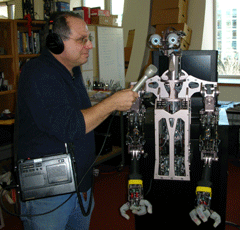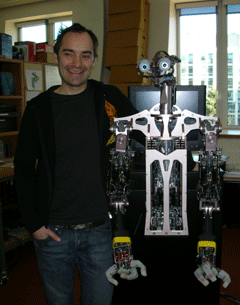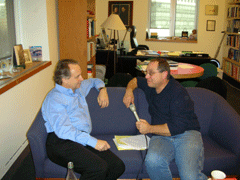The Future of Robotics
Air Date: Week of July 20, 2007

(Photo: Emily Taylor)
From vacuum cleaners and lawnmowers to military landmine detectors, robots are becoming increasingly present in our daily lives. Living on Earth’s Bruce Gellerman visits MIT’s Computer Science and Artificial Intelligence Laboratory (CSAIL) to meet a humanoid robot named Domo, its creator, PhD student Aaron Elsinger, and the man behind all the magic, CSAIL director Rodney Brooks.
Transcript
GELLERMAN: Increasingly, living on earth means living with robots. Sharing the planet with ever-more intelligent machines that perform tasks from the mundane, like the robo-lawnmower that cuts your grass, to the highly specialized like robo-docs that do surgery. The word “robot” comes from the Slavic word “robota” or work, and was first used by Czech science fiction writer Karel Capek in 1921. Ever since, robots have stirred and captured our imaginations.
[FAMOUS ROBOT MOVIE MONTAGE FEATURING: "Robbie The Robot" from 'Forbidden Planet (MGM - 1956),
"HAL 9000" from '2001: A Space Odyssey (MGM - 1968),
"Robot" from 'Lost in Space: The Movie (New Line - 1998),
"C-3P0" and "R2-D2" from 'Star Wars: Episode IV - A New Hope (LucasFilm - 1977),
Rodney Brooks sound clip from 'Fast, Cheap & Out of Control' a film by Errol Morris (Sony Pictures - 1997)]
GELLERMAN: Robosapiens, life-like robots that obey our every command are still the stuff of Hollywood. But at the just concluded consumer electronics show in Las Vegas, robots for the home were being hailed as the next big thing. It's an industry poised to amaze.
[ROBOT SOUNDS]
To see first hand where things are headed check out MIT's humanoid robotics group. Here on the Cambridge, Massachusetts campus, grad student Aaron Edsinger has just put the finishing touches on one of the world's most advanced robots.
EDSINGER: This is my PhD work. This is a, a humanoid robot named Domo.
GELLERMAN: Domo means…?
EDSINGER: Domo means thanks in Japanese but it’s also the name of a song, Domo Arigato, Mr. Roboto.
GELLERMAN: Domo looks a lot like a human. It’s got eyeballs and it’s looking at me. And it’s got this arm with biceps, triceps. I mean put a skin over it and…

Bruce Gellerman chats up Domo.
(Photo: Emily Taylor)
GELLERMAN: Is it perceiving me?
EDSINGER: It can. At the moment the visual cortex is sort of switched off. But when everything is running it can see you, it can interact with you, reach to you, respond to your physical contact. What you see here is that I can grab the arm and it can sense that and it can respond to it when I push on it. So, it’s actually sensing a person’s interaction with it. And the idea is that it’s sort of a partner robot. It works with you to do something, a manual task.
GELLERMAN: Well it’s missing an important part. It’s got no legs.
EDSINGER: No legs, yeah. Legs, legs are hard. We don’t focus on the mobility so much although I think that’s the next obvious step.
GELLEMRNA: That would be major Domo.
EDSINGER: Major Domo, yes.
GELLERMAN: So, what’s the computing power of this?
EDSINGER: This is actually about 15 computers that go into running the robot when everything is turned on. Now most of that is for computer vision. Motor control actually doesn’t take a whole lot of computation.

Aaron Edsinger with his robot Domo. (Photo: Emily Taylor)
GELLERMAN: When you were working and building this, did you ever think it was, well another person? Did you ever react to it and start asking it things and expecting things?
EDSINGER: Sure, yeah. You know that it’s a piece of metal and motors. And you know all the code that’s going on behind it but every now and then it acts in a way that you don’t expect. At a certain level it’s hard to know what’s going to happen to it, how it’s going to respond because its behavior is not scripted. It’s really responding to its environment and reacting to that. So sometimes you get that glimpse of it being very life-like.
GELLERMAN: Well, thank you very much congratulations.
[MUSIC: Styx “Mr. Roboto” from ‘Kilroy Was Here’ (A&M – 1983)]
GELLERMAN: Grad student Aaron Edsinger built Domo at MIT’s computer science and artificial intelligence laboratory. The lab’s director is Rodney Brooks. He’s also chief technology officer of Irobot, a company that produces robotic vacuum cleaners. You might have seen Brooks in the movie Fast Cheap and Out of Control playing himself, an eccentric designer of robots.
MOVIE: When I switched the things on the lights flashed and the machine came to life. It moved! Some people believe that we are going to replace ourselves by building these machines and that may be.
GELLERMAN: Rodney Brooks’ office in a space-age building at MIT is a study in controlled chaos. We sit on a couch opposite a wall with a poster of Fast Cheap and Out of Control, and a photo of Brooks and a robot playing with a slinky.
BROOKS: Yeah, that was a robot named Cog, a humanoid form but no legs. And we were really interested, and still are, in robots with arms that are safe to be in the same space as whereas a robot in a factory with arms, you don’t want to be near. So, trying to make robots that are safe to interact with so that ultimately we can have robots manipulating things in the world, doing stuff with us, partnering with us. And for us Baby Boomers, this is going to be important for us in our old age.
GELLERMAN: Oh really, why?
BROOKS: Well, if you look at the demographics of the world there’s going to be many many more elderly compared to working age people, same problem with our social security financing. And where are we going to get all the people to help us in our homes and in our hospitals, we’re going to have to have more robotics help and assistance.

Bruce Gellerman (right) and CSAIL Director Rodney Brooks discuss the future of robotics. (Photo: Emily Taylor)
BROOKS: Well, we’re not there yet, but I think we’re making good progress towards it. You know, we’re starting to see robots in people’s homes. Now, by the standards of 30 years from now those robots are fairly simple. The home cleaning robots, my company Irobot happens to be the biggest manufacturer of them.
GELLERMAN: You’re making, basically vacuum cleaners.
BROOKS: Yeah but they’re robotic vacuum cleaners. You press the clean button and you walk away and they clean the house.
[SOUND OF ROBOTIC VACUUM CLEANER]
GELLERMAN: That thing really works!
BROOKS: Yeah, of course it works! (laughs)
GELLERMAN: But I’m thinking, you know, the Jetsons, where they have Rosie the robot.
BROOKS: Well, we’re not going to have Rosie any time soon. But you gotta think, what were computers like 30 years ago? What are computers like now?
GELLERMAN: Well, we’re in the William H. Gates building at MIT. And Bill Gates has an article in the January issue Scientific America in which he talks about the future of robots. And he says they’re going to be as ubiquitous as computers.
BROOKS: Yeah, he makes the analogy between robots today and computers when Microsoft got started and his company was one of the leading forces in changing what computers could do.
GELLERMAN: So, what do we need to accomplish between where we are now with your vacuum cleaner robot and robots that kind of have arms that swing and paint and where are we going to be in 10 years?
BROOKS: Well, I say that there’s 2 really critical things that we as researchers should be working on at the universities. We need the visual object recognition capabilities of a two-year-old child and the manual dexterity of a 6-year-old child. They are the 2 capabilities that I think are important to go after in the research demand right now. We’re making progress on both of them although both have a long history of not necessarily great success over the years.
GELLERMAN: People think about robots, I think they think about humanoid robots, that is things that look like us that we create in our own images. When you think robot is that what you’re thinking of?
BROOKS: I could believe either way. It could be that we want robots with our own form or we could have robots with other forms. But we will want to be able to interact with them socially. Let me tell you what I mean by that. We interact with our dogs socially. We know what our dog is looking at, what the dog is paying attention to. Our dogs know what our gaze direction is. They understand us. We understand them. I think we’re going to need that intuitive understanding of what our robots are trying to do. And our robots are going to need the intuitive understanding of what it is we’re trying to do and then co-exist with us and help us. And if they don’t do that, no ones going to buy it.
GELLERMAN: When we design these robots it seems like we design them in our own image. And that when we try to give them intelligence and maybe even consciousness that it’s really not saying what is a robot. We’re asking the question what is human?
BROOKS: Well, that’s I think one of the biggest drivers for us in my research lab here has been what is human and trying to understand that by building models. For me the most remarkable thing has been how simple the social interaction parts are to build. Now what’s hard is object recognition, manipulation, the stuff that two-year-olds can do.
GELLERMAN: So, now look out 100 years. I know it’s the stuff of science fiction. Are we going to have robot people?
BROOKS: Well, we don’t have robot birds yet. We’ve got really good machines that fly but we don’t have machines that fly like birds. So, I think that we get the essence, but whether we go to the trouble of making it identical to a human, I don’t know. Now could it be 100 years from now that we have robots that are truly intelligent and true beings? In principle, absolutely. You know, I as a sort of strong scientist think that we are machines. You and I are machines. We’re made of biomolecules. Biomolecules interact through the laws of chemistry and physics. So we are machines. So in principle it seems that we should be able to have machines built out of other stuff, which are intelligent like us. Now another question is, are we humans smart enough to build such machines? That’s an open question. You know, you look at a raccoon. A raccoon is very dextrose with its hands. You know it can unlock things and get into places and stuff. But I don’t know any one who’s looked at a raccoon and thought, hey one day that raccoon is going to build a robot raccoon just like itself.
GELLERMAN: (laughing)
BROOKS: So you can imagine the guys from Alpha Centauri, from another solar system, are up in their UFOs they’re looking down, and they’re looking at MIT and they say, “Oh look at those little professors there. They’re going to build robot versions of themselves. Aren’t they cute!
GELLERMAN: It seems that this is as much philosophy as physics.
BROOKS: It’s a mixture of the two. And therefore it’s very murky. And therefore many scientists feel very uncomfortable about it.
GELLERMAN: How do you feel about it?
BROOKS: I feel fascinated. What could be more fun, except going to space?
GELLERMAN: Dr. Brooks, I want to thank you very much.
BROOKS: Thank you.
Links
MIT’s Computer Science and Artificial Intelligence Laboratory
Aaron Edsinger-Gonzales’s website
“A Robot in Every Home” by Bill Gates in Scientific American
Living on Earth wants to hear from you!
Living on Earth
62 Calef Highway, Suite 212
Lee, NH 03861
Telephone: 617-287-4121
E-mail: comments@loe.org
Newsletter [Click here]
Donate to Living on Earth!
Living on Earth is an independent media program and relies entirely on contributions from listeners and institutions supporting public service. Please donate now to preserve an independent environmental voice.
NewsletterLiving on Earth offers a weekly delivery of the show's rundown to your mailbox. Sign up for our newsletter today!
 Sailors For The Sea: Be the change you want to sea.
Sailors For The Sea: Be the change you want to sea.
 The Grantham Foundation for the Protection of the Environment: Committed to protecting and improving the health of the global environment.
The Grantham Foundation for the Protection of the Environment: Committed to protecting and improving the health of the global environment.
 Contribute to Living on Earth and receive, as our gift to you, an archival print of one of Mark Seth Lender's extraordinary wildlife photographs. Follow the link to see Mark's current collection of photographs.
Contribute to Living on Earth and receive, as our gift to you, an archival print of one of Mark Seth Lender's extraordinary wildlife photographs. Follow the link to see Mark's current collection of photographs.
 Buy a signed copy of Mark Seth Lender's book Smeagull the Seagull & support Living on Earth
Buy a signed copy of Mark Seth Lender's book Smeagull the Seagull & support Living on Earth

